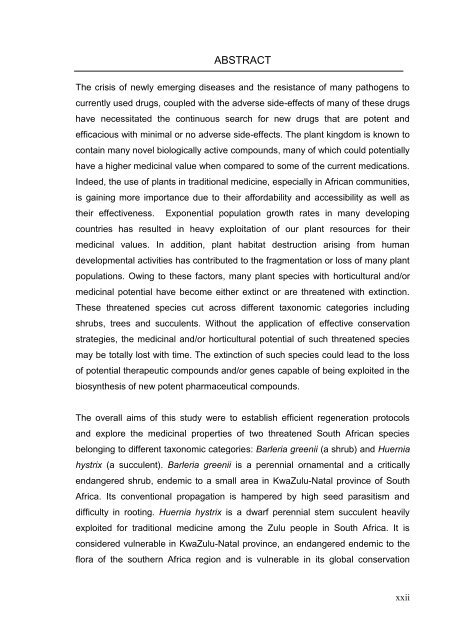Micropropagation and medicinal properties of Barleria greenii
Micropropagation and medicinal properties of Barleria greenii
Micropropagation and medicinal properties of Barleria greenii
You also want an ePaper? Increase the reach of your titles
YUMPU automatically turns print PDFs into web optimized ePapers that Google loves.
ABSTRACT<br />
The crisis <strong>of</strong> newly emerging diseases <strong>and</strong> the resistance <strong>of</strong> many pathogens to<br />
currently used drugs, coupled with the adverse side-effects <strong>of</strong> many <strong>of</strong> these drugs<br />
have necessitated the continuous search for new drugs that are potent <strong>and</strong><br />
efficacious with minimal or no adverse side-effects. The plant kingdom is known to<br />
contain many novel biologically active compounds, many <strong>of</strong> which could potentially<br />
have a higher <strong>medicinal</strong> value when compared to some <strong>of</strong> the current medications.<br />
Indeed, the use <strong>of</strong> plants in traditional medicine, especially in African communities,<br />
is gaining more importance due to their affordability <strong>and</strong> accessibility as well as<br />
their effectiveness. Exponential population growth rates in many developing<br />
countries has resulted in heavy exploitation <strong>of</strong> our plant resources for their<br />
<strong>medicinal</strong> values. In addition, plant habitat destruction arising from human<br />
developmental activities has contributed to the fragmentation or loss <strong>of</strong> many plant<br />
populations. Owing to these factors, many plant species with horticultural <strong>and</strong>/or<br />
<strong>medicinal</strong> potential have become either extinct or are threatened with extinction.<br />
These threatened species cut across different taxonomic categories including<br />
shrubs, trees <strong>and</strong> succulents. Without the application <strong>of</strong> effective conservation<br />
strategies, the <strong>medicinal</strong> <strong>and</strong>/or horticultural potential <strong>of</strong> such threatened species<br />
may be totally lost with time. The extinction <strong>of</strong> such species could lead to the loss<br />
<strong>of</strong> potential therapeutic compounds <strong>and</strong>/or genes capable <strong>of</strong> being exploited in the<br />
biosynthesis <strong>of</strong> new potent pharmaceutical compounds.<br />
The overall aims <strong>of</strong> this study were to establish efficient regeneration protocols<br />
<strong>and</strong> explore the <strong>medicinal</strong> <strong>properties</strong> <strong>of</strong> two threatened South African species<br />
belonging to different taxonomic categories: <strong>Barleria</strong> <strong>greenii</strong> (a shrub) <strong>and</strong> Huernia<br />
hystrix (a succulent). <strong>Barleria</strong> <strong>greenii</strong> is a perennial ornamental <strong>and</strong> a critically<br />
endangered shrub, endemic to a small area in KwaZulu-Natal province <strong>of</strong> South<br />
Africa. Its conventional propagation is hampered by high seed parasitism <strong>and</strong><br />
difficulty in rooting. Huernia hystrix is a dwarf perennial stem succulent heavily<br />
exploited for traditional medicine among the Zulu people in South Africa. It is<br />
considered vulnerable in KwaZulu-Natal province, an endangered endemic to the<br />
flora <strong>of</strong> the southern Africa region <strong>and</strong> is vulnerable in its global conservation<br />
xxii

















